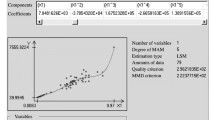Abstract
Using the focusing equation, the equation for the cosmological angular diameter distance1 is derived, based on the ideas of Academician Zel’dovich, namely, that the distribution of matter at small angles is not homogeneous, and the light cone is close to being empty. We propose some ways of testing a method for measuring the angular diameter distances and show that the proposed method leads to results that agree better with the experimental data than those obtained by the usual methods.
Similar content being viewed by others
References
Ya. B. Zeldovich, Sov. Astron. 8, 13 (1964).
A. V. Nikolaev and S. V. Chervon, EPJC 75, 75 (2015).
R. K. Sachs, Proc. Roy. Soc. London 264, 309 (1961).
G. F. R. Ellis, Gen. Rel. Grav. 39, 1047 (2007).
E. Poisson, A Relativist’s Toolkit. The Mathematics of Black-Hole Mechanics (Cambridge University, Cambridge, 2004).
P. Schneider, J. Ehlers, and E. E. Falco, Gravitational Lenses (Springer, Berlin, 1999).
G. Ellis, Gen. Rel. Grav. 41, 581 (2009).
R. F. L. Holanda, R. S. Goncalves, and J. S. Alcaniz, JCAP 1206, 022 (2012).
A. V. Nikolaev and S. V. Chervon, Int. J. Mod. Phys. A 31, 1641013 (2016).
J.-P. Uzan, N. Aghanim, and Y. Mellier, Phys. Rev. D 70, 083533 (2004).
M. Sereno, E. Piedipalumbo, and M. V. Sazhin, Mon. Not. Roy. Astron. Soc. 335, 1061 (2002).
E. D. Reese, J. E. Carlstrom, M. Joy, J. J. Mohr, L. Grego, and W. L. Holzapfel, Astroph. J. 581, 53 (2002).
S. J. LaRoque, M. Bonamente, J. E. Carlstrom, M. K. Joy, D. Nagai, E. D. Reese, and K. S. Dawson, Astroph. J. 652, 917 (2006).
S. Ettori, A. Morandi, P. Tozzi, I. Balestra, S. Borgani, P. Rosati, L. Lovisari, and F. Terenziani, Astron. Astroph. 501, 61 (2009).
S. W. Allen, D. A. Rapetti, R. W. Schmidt, H. Ebeling, R. G. Morris, and A. C. Fabian, Mon. Not. Roy. Astron. Soc. 383, 879 (2008).
P. Schneider and A. Weiss, Astroph. J. 327, 526 (1988).
S. Seitz, P. Schneider, and J. Ehlers, Class. Quantum Grav. 11, 2345 (1994).
Author information
Authors and Affiliations
Corresponding author
Additional information
This issue of the journal is dedicated to the centenary of Prof. K.P. Staniukovich.
Rights and permissions
About this article
Cite this article
Nikolaev, A.V., Chervon, S.V. The effect of universe inhomogeneities on cosmological distance measurements. Gravit. Cosmol. 22, 208–211 (2016). https://doi.org/10.1134/S0202289316020122
Received:
Published:
Issue Date:
DOI: https://doi.org/10.1134/S0202289316020122




